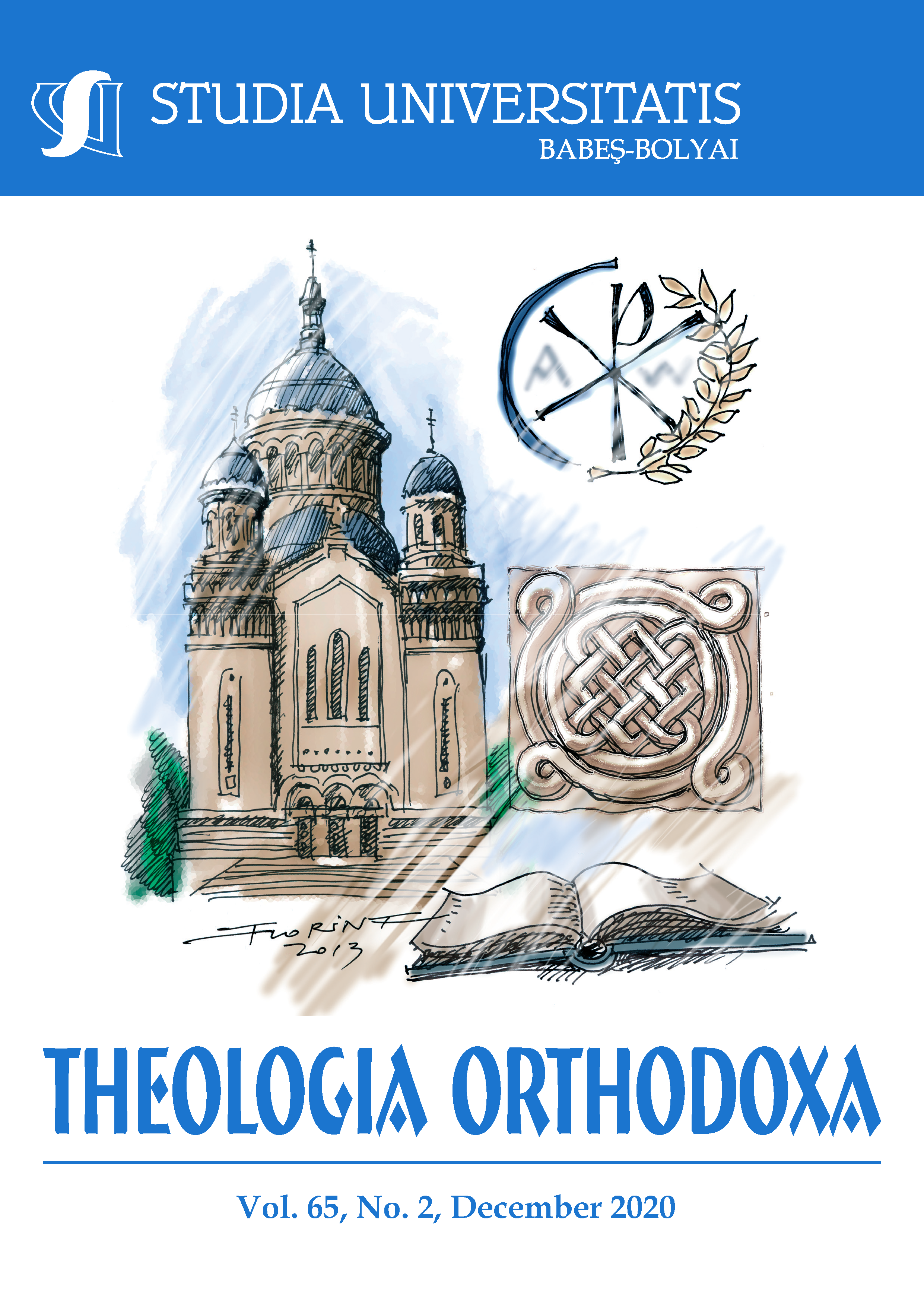THE PSALMS, THE HYMNS, AND THE TEXTS OF THE OLD TESTAMENT AND THEIR USE IN HOLY MONDAY AND TUESDAY
DOI:
https://doi.org/10.24193/subbto.2020.2.08Keywords:
Old Testament, Holy Week, Holy Monday, Holy Tuesday, liturgy, psalmsAbstract
The worship of the Orthodox Eastern Church involves a multitude of references hints and images of the Old Testament, in all the sequences (liturgies) and hymns. Particularly in the Holy and Great Week, the texts of the Old Testament are used with particular emphasis. On Holy Monday and on Holy Tuesday there is use of the texts of the Old Testament. Holy and Great Monday, Tuesday and Wednesday remind us of the eschatological meaning of Pascha. In this paper, we are going to analyze the real and deep influence of the Old Testament to these days of Holy Monday and Tuesday and why the Orthodox Church chose to use the Old Testament although the Jews refused Christ and led him to death. The goal is to show that Orthodox Greek Christians use these texts from the Old Testament because they have no hostile attitude against Jews.
References
“Ode 8. (Eirmos), in the matins prayers of Holy Monday”, The Holy Week, (Athens, 2005), 90.
Adamo, D. Tuesday (Unisa), “The Nameless African Wife of Potiphar and her contribution to Ancient Israel.” Old Testament Essays, 26.2 (2013): 221-246.
Andrew of Caesarea of Cappadocia, In Joannis theologi Apocapypsin, 18, PG 106, 273.
Athanasius of Alexandria, Quaestiones in scripturam sacram, PG 28, 716C.
Athanasius of Alexandria, Quaestiones in scripturam sacram, PG 28, 716D.
Barclay, W. The Gospel of Matthew, Vol. 2. London, 1975.
Boring, M. E., Craddock, F. B. The People’s New Testament Commentary. Louisville- Kentucky 2009), 153, 154, 266.
Cotter, W. J. “For It Was Not the Season for Figs.” The Catholic Bible Quarterly 48 (1986): 62-66.
Cyril of Alexandria, Collectio dictorum veteris testamenti, PG 77, 1168C- 1184A,
Cyril of Alexandria, Commentaries in Isaiam Prophetam, PG 70, 573CD.
Cyril of Alexandria, Commentarii in Lucam, PG 72, 764B; Ibidem, PG 72, 764C.
Cyril of Alexandria, In Lucam, PG 761D-764D.
Donahue, J. R., SJ. and Harriton, D. J. The Gospel of Mark. Minnesota: Collegeville, 2002.
Dragas, G. D. Saint Athanasius of Alexandria: Original Research and New Perspectives. Rollinsford, 2005.
Epiphanius of Cyprus, Tractatus de numerorum mysteriis, PG 43, 512CD.
Esler, P. F. “The Incident of the Withered Fig Tree in Mark 11: A New Source and Redactional Explanation”, Journal for the Study of the New Testament 28 (1/2005): 49.
Euthymius Zigabenus, In Markum, PG 129,∙829CD, 832A.
Euthymius Zigabenus, In Mattheum, PG 129, 557B-D, 559AB, 613A;
Gast, F. A.,“The Relation of the Old Testament to the New.”The Hebrew Student, 2.8 (April 1883): 234-239.
Heller, E. G. “Bible, Midrashim and Medieval Tales: The Artistic Journey of Potiphar’s Wife,” in Women of the Hebrew Bible and their Afterlives, vol. 1. Edited by P. Hawkins and L.C. Stahlberg, Sheffield, 2009.
Hieke, Th., “Atonement in the Prayer of Azariah (Dan. 3:40).” In Deuterocanonical Additions of the Old Testament Books, vol. 5. Edited by G. G. Xeravits and J. Zsengeller, 43-59 (Budapest, 2010).
John Chrysostom, In Johanneum, 24, PG 59, 602B.
John Chrysostom, In Matthaeum, PG 58, 633D.
John Chrysostom, In Mattheum, 67, PG 58, 633D-634A.
John Chrysostom, In parabolam de ficu, PG 59, 589A.
Kalantzakis, S. Introduction to the Old Testament. Thessaloniki, 2006.
Klostermann, E., Origenes Werke, vol. 3, Die griechischen christlichen, Schriftsteller 6. Leipzig: Hinrichs, 1901.
Matthis, Th. The Rest of the Bible: A Guide to the Old Testament of the Early Church, (Kentucky, 2011.
Maximus the Confessor, Quaestiones ad Thalassium, 20, PG 90, 309C-312B.
Miller, J. A journey through Holy week: From the Gospel of Matthew, Oregon: Eugene, 2019.
Origen of Alexandria, In Jeremiah, 18, Section 5.78-80, 13, 432A-C.
Puett, Terry L. The Prophecy Puzzle: Putting the Pieces Together (AuthorHouse, 2004).
Schiller, Gertrude. Iconography of Christian Art, trans. J. Seligman. New York Greenwich, 1971.
Schorn, J. “What is the relationship between the Old and New Testaments? Though they sometimes seem dissimilar, the two parts of the Bible are all about fulfillment. “U.S. Catholic 59.2 (February 2014): 54.
Stergiou, R. “The Old Testament in the Orthodox Church.” Voice in the wilderness, 5 (1997): 4-6.
Strobe,D. B. “Not the Seasons for Figs.” Collected Words, in Dynamic Preaching, ed. D. B. Strobe, (2005), 37-46.
Theophylact of Ohrid, In Mattheum, PG 123, 373B.
Vistar, D. V. The Significance of the Temple Incident in the Narratives of the Four Gospels. Oregon: Eugene, 2015.
K. Ware (ed.), Mary Mother. The Lenten Triodion. South Canaan, 1978.
Internet resources
Kimball, V. M. “The Bible and Ancient Liturgy: Good Friday Texts in the Eastern Orthodox Tradition”, Teaching the bible, https://www.sbl-site.org/assets/pdfs/TB9_Liturgy_VK.pdf, [Accessed on 21 May 2019].
Klimenko, V. E. “The Orthodox Teaching on Personal Salvation”, Part 1, 9/12/2013, http://saintandrewgoc.org/home/2013/12/19/the-orthodox-teaching-on-personal-salvation.html. [Accessed on 23/4/2019].
Kosloski, Ph. “Who were the Pharisees and why did Jesus oppose them?”, 3/4/2018, https://aleteia.org/2018/03/04/who-were-the-pharisees-and-why-were-they-so-bad/ [Accessed on 7 June 2019].
Schifferdecker, K. M. “Commentary on Psalm 150”, 11/4/2010, https://www.workingpreacher.org/preaching.aspx?commentary_id=562, [Accessed on 6 June 2019].
Schmemann, Al. “Holy Week: A Liturgical Explanation for the Days of Holy Week,” 22/04/2019, https://oca.org/saints/lives/2019/04/22/21-great-and-holy-monday [Accessed on 05-05-2019].
Downloads
Published
How to Cite
Issue
Section
License
Copyright (c) 2020 Studia Universitatis Babeș-Bolyai Theologia Orthodoxa

This work is licensed under a Creative Commons Attribution-NonCommercial-NoDerivatives 4.0 International License.





 ISSN (print): 1224-0869, ISSN (online): 2065-9474, ISSN-L: 2065-9474
ISSN (print): 1224-0869, ISSN (online): 2065-9474, ISSN-L: 2065-9474